samsung LN23R71BAX, LN23R71WAX, LN26R71BAX, LN32R71BAX, LN40R71BAX Service Manual

TFT-LCD TV
Chassis GNB23MLA GNB26MLA GNB32MLA GNB40MLA
Model
LN23R71BAX
LN23R71WAX
LN26R71BAX
LN32R71BAX
LN40R71BAX
SERVICE Manual
|
|
|
TFT-LCD TV |
Feature |
-RF, HDMI, PC(Analog), Component, Video, S-Video
-Brightness : 500cd/m2
-Contrast Ratio:
23"/ 26" : 3000:1, 32"/ 40" : 5000:1
-Response time : 8ms
-Dynamic contrast
-PIP(on COM, PC, HDMI)

Contents
1.Precautions………………………………………………………………………………………………………………………………………1-1 1-1 Safety Precautions ……………………………………………………………………………………………………………………… 1-1 1-2 Servicing Precautions …………………………………………………………………………………………………………………… 1-2 1-3 Static Electricity Precautions …………………………………………………………………………………………………………… 1-2 1-4 Installation Precautions…………………………………………………………………………………………………………………… 1-3
2. Product specifications …………………………………………………………………………………………………………………………2-1
2-1 Fashion Feature…………………………………………………………………………………………………………………………… 2-1
2-2 LN23R71BAX/LN23R71WAX Specifications ………………………………………………………………………………………… 2-2
2-3 LN26R71BAX Specifications …………………………………………………………………………………………………………… 2-3
2-4 LN32R71BAX Specifications …………………………………………………………………………………………………………… 2-4
2-5 LN40R71BAX Specifications …………………………………………………………………………………………………………… 2-5
2-6 Spec Comparison ………………………………………………………………………………………………………………………… 2-6
2-7 Option Specification ……………………………………………………………………………………………………………………… 2-7
3. Alignments and Adjustments …………………………………………………………………………………………………………………3-1
3-1 Service Instruction ……………………………………………………………………………………………………………………… 3-1 3-2 How to Access Service Mode …………………………………………………………………………………………………………… 3-2 3-3 Factory Data ……………………………………………………………………………………………………………………………… 3-3 3-4 Service Adjustment ……………………………………………………………………………………………………………………… 3-9 3-5 Software Upgrade ……………………………………………………………………………………………………………………… 3-12
4. Troubleshooting ………………………………………………………………………………………………………………………………4-1 4-1 First Checklist for Troubleshooting ………………………………………………………………………………………………………4-1 4-2 Checkpoints by Error Mode ……………………………………………………………………………………………………………… 4-2
5. Exploded View and Parts List …………………………………………………………………………………………………………………5-1 5-1 LN23R71BAX/LN23R71WAX Exploded View ………………………………………………………………………………………… 5-1 5-2 LN23R71BAX Parts list…………………………………………………………………………………………………………………… 5-2 5-3 LN23R71WAX Parts list ………………………………………………………………………………………………………………… 5-2 5-4 LN26R71BAX Exploded View …………………………………………………………………………………………………………… 5-3 5-5 LN26R71BAX Parts list…………………………………………………………………………………………………………………… 5-4 5-6 LN32R71BAX Exploded View …………………………………………………………………………………………………………… 5-5 5-7 LN32R71BAX Parts list…………………………………………………………………………………………………………………… 5-6 5-8 LN40R71BAX Exploded View …………………………………………………………………………………………………………… 5-7 5-9 LN40R71BAX Parts list…………………………………………………………………………………………………………………… 5-8
6. Electrical Parts List ……………………………………………………………………………………………………………………………6-1 6-1 LN23R71BAX/LN23R71WAX Parts List ……………………………………………………………………………………………… 6-1 6-2 LN26R71BAX Parts List………………………………………………………………………………………………………………… 6-18 6-3 LN32R71BAX Parts List………………………………………………………………………………………………………………… 6-33 6-4 LN40R71BAX Parts List………………………………………………………………………………………………………………… 6-50

Contents
7.Block Diagram …………………………………………………………………………………………………………………………………7-1
8.Wiring Diagram …………………………………………………………………………………………………………………………………8-1 8-1 Wiring Diagram …………………………………………………………………………………………………………………………… 8-1 8-2 Main Board Layout ……………………………………………………………………………………………………………………… 8-2 8-3 PIN characteristic ………………………………………………………………………………………………………………………… 8-3 8-4 Power Board Layout ……………………………………………………………………………………………………………………… 8-6
9. Schematic Diagrams……………………………………………………………………………………………………………………………9-1 9-1 Power_Sound Schematic Diagram……………………………………………………………………………………………………… 9-1 9-2 Jack Schematic Diagram ………………………………………………………………………………………………………………… 9-2 9-3 Micom Schematic Diagram ……………………………………………………………………………………………………………… 9-3 9-4 SVP-PX/PX-Power/LBE-Option Schematic Diagram ………………………………………………………………………………… 9-4 9-5 Application Schematic Diagram ………………………………………………………………………………………………………… 9-5
10. Operating Instructions and Installation………………………………………………………………………………………………………10-1 10-1 Front …………………………………………………………………………………………………………………………………… 10-1 10-2 Connection Panel ……………………………………………………………………………………………………………………… 10-2 10-3 Remote control ………………………………………………………………………………………………………………………… 10-5 10-4 Installing the Stand …………………………………………………………………………………………………………………… 10-6 10-5 Installing the Wall Mount Kit ………………………………………………………………………………………………………… 10-6
11. Disassembly and Reassembly ………………………………………………………………………………………………………………11-1 11-1 Disassembly …………………………………………………………………………………………………………………………… 11-1 11-2 Reassembly …………………………………………………………………………………………………………………………… 11-5
12. PCB Diagram …………………………………………………………………………………………………………………………………12-1 12-1 Main PCB Diagram …………………………………………………………………………………………………………………… 12-1 12-2 Power PCB Diagram 23" ………………………………………………………………………………………………………………12-2 12-3 Power PCB Diagram 26", 32" ………………………………………………………………………………………………………… 12-3 12-4 Power PCB Diagram 40" ……………………………………………………………………………………………………………… 12-4
13. Circuit Descriptions ……………………………………………………………………………………………………………………………13-1
13-1 Block description ……………………………………………………………………………………………………………………… 13-1
13-2 Main Block ……………………………………………………………………………………………………………………………… 13-3
13-3 SMPS Board …………………………………………………………………………………………………………………………… 13-4
14. Reference Infomation ……………………………………………………………………………………………………………………… 14-1
14-1 Technical Terms ……………………………………………………………………………………………………………………… 14-1
14-2 Pin Assignments ……………………………………………………………………………………………………………………… 14-4
14-3 Timing Chart …………………………………………………………………………………………………………………………… 14-6
14-4 Panel Description …………………………………………………………………………………………………………………… 14-10
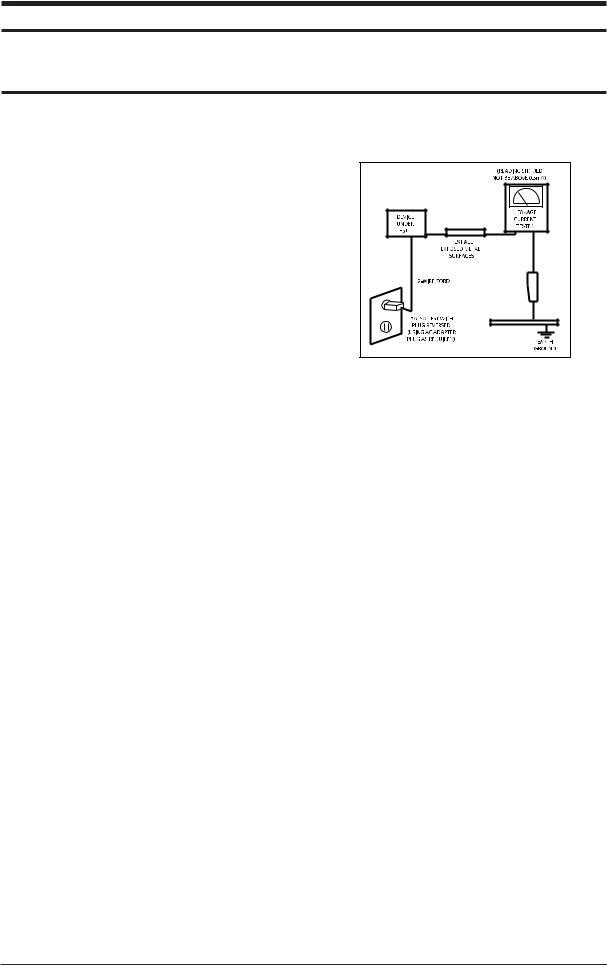
1 Precautions
1 Precautions
Follow these safety, servicing and ESD precautions to prevent damage and to protect against potential hazards such as electrical shock.
1-1 Safety Precautions
1-1-1 Warnings
1.For continued safety, do not attempt to modify the circuit board.
2.Disconnect the AC power and DC Power Jack before servicing.
1-1-2 Servicing the LCD Monitor
1.When servicing the LCD Monitor Disconnect the AC line cord from the AC outlet.
2.It is essential that service technicians have an accurate voltage meter available at all times. Check the calibration of this meter periodically.
1-1-3 Fire and Shock Hazard
Before returning the monitor to the user, perform the following safety checks:
1.Inspect each lead dress to make certain that the leads are not pinched or that hardware is not lodged between the chassis and other metal parts in the monitor.
2.Inspect all protective devices such as nonmetallic control knobs, insulating materials, cabinet backs, adjustment and compartment covers or shields, isolation resistor-capacitor networks, mechanical insulators, etc.
3.Leakage Current Hot Check (Figure 1-1):
WARNING: Do not use an isolation transformer during this test.
Use a leakage current tester or a metering system that complies with American National Standards Institute (ANSI C101.1, Leakage Current for Appliances), and Underwriters Laboratories
(UL Publication UL1410, 59.7).
Figure 1-1. Leakage Current Test Circuit
1-1-4 Product Safety Notices
Some electrical and mechanical parts have special safety-related characteristics which are often not evident from visual inspection. The protection they give may not be obtained by replacing them with components rated for higher voltage, wattage, etc. Parts that have special safety characteristics are identified by  on schematics and parts lists. A substitute replacement that does not have the same safety characteristics as the recommended replacement part might create shock, fire and/or other hazards. Product safety is under review continuously and new instructions are issued whenever appropriate.
on schematics and parts lists. A substitute replacement that does not have the same safety characteristics as the recommended replacement part might create shock, fire and/or other hazards. Product safety is under review continuously and new instructions are issued whenever appropriate.
1-1

1 Precautions
1-2 Servicing Precautions
WARNING: |
An electrolytic capacitor installed with the wrong polarity might explode. |
Caution: |
Before servicing units covered by this service manual, read and follow the Safety |
|
Precautions section of this manual. |
Note: |
If unforeseen circumstances create conflict between the following servicing precautions and any of the safety |
|
precautions, always follow the safety precautions. |
1-2-1 General Servicing
Precautions
1.Always unplug the unit s AC power cord from the AC power source and disconnect the DC Power Jack before attempting to:
(a) remove or reinstall any component or assembly, (b) disconnect PCB plugs or connectors, (c) connect a test component in parallel with an electrolytic capacitor.
2.Some components are raised above the printed circuit board for safety. An insulation tube or tape is sometimes used. The internal wiring is sometimes clamped to prevent contact with thermally hot components. Reinstall all such elements to their original position.
3.After servicing, always check that the screws, components and wiring have been correctly reinstalled. Make sure that the area around the serviced part has not been damaged.
4.Check the insulation between the blades of the AC plug and accessible conductive parts (examples: metal panels, input terminals and earphone jacks).
5.Insulation Checking Procedure: Disconnect the power cord from the AC source and turn the power switch ON. Connect an insulation resistance meter (500 V) to the blades of the AC plug.
The insulation resistance between each blade of the AC plug and accessible conductive parts (see above) should be greater than 1 megohm.
6.Always connect a test instrument s ground lead to the instrument chassis ground before connecting the positive lead; always remove the instrument s ground lead last.
1-3 Static Electricity Precautions
Some semiconductor (solid state) devices can be easily damaged by static electricity. Such components are commonly called Electrostatically Sensitive Devices (ESD). Examples of typical ESD are integrated circuits and some field-effect transistors. The following techniques will reduce the incidence of component damage caused by static electricity.
1.Immediately before handling any semiconductor components or assemblies, drain the electrostatic charge from your body by touching a known earth ground. Alternatively, wear a discharging wrist-strap device. To avoid a shock hazard, be sure to remove the wrist strap before applying power to the monitor.
2.After removing an ESD-equipped assembly, place it on a conductive surface such as aluminum foil to prevent accumulation of an electrostatic charge.
3.Do not use freon-propelled chemicals. These can generate electrical charges sufficient to damage ESDs.
4.Use only a grounded-tip soldering iron to solder or desolder ESDs.
5.Use only an anti-static solder removal device. Some solder removal devices not classified as anti-static can generate electrical charges sufficient to damage ESDs.
6.Do not remove a replacement ESD from its protective package until you are ready to install it. Most replacement ESDs are packaged with leads that are electrically shorted together by conductive foam, aluminum foil or other conductive materials.
7.Immediately before removing the protective material from the leads of a replacement ESD, touch the protective material to the chassis or circuit assembly into which the device will be installed.
Caution: Be sure no power is applied to the chassis or circuit and observe all other safety
precautions.
8.Minimize body motions when handling unpackaged replacement ESDs. Motions such as brushing clothes together, or lifting your foot from a carpeted floor can generate enough static electricity to damage an ESD.
1-2

2 Product Specifications
2-2 LN23R71BAX/LN23R71WAX Specifications
Item |
|
|
Description |
|
|
|
|
LCD Panel |
TFT-LCDpanel,RGBverticalstripe,normalywhite,23-Inchviewable,0.372(H)x0.372(V)mmpixelpitch |
||
|
|
|
|
Scanning Frequency |
Horizontal: 30kHz~61kHz(Automatic)/Vertical: 60Hz~75Hz(Automatic) |
||
|
|
|
|
Display Colors |
16.7Millioncolors |
||
|
|
|
|
Maximum Resolution |
Horizontal:1360Pixels |
||
|
Vertical |
:768Pixels |
|
Input Video Signal |
Analog0.7Vp-p± 5%positiveat75Ω,internallyterminated |
||
|
|
|
|
Input Sync Signal |
Type: SeperateH/V |
||
|
Level: TTLlevel |
||
|
|
|
|
Maximum Pixel Clock rate |
80MHz |
|
|
Active Display |
508.125mm/285.696mm |
||
Horizontal/Vertical |
|||
|
|
|
|
ACpowervoltage&Frequencya |
AC110,60Hz |
||
Power Consumption |
100W<1W |
||
|
|
|
|
Dimensions(W x D x H) |
|
|
|
Set |
594x75x425.5mm(23.38x 2.95x16.75inch)_withoutstand |
||
|
594x215.5x475.5mm(23.38x8.48x18.72)_withstand |
||
|
|
|
|
Weight |
|
|
|
Set(After installation Stand) |
8kg(17Ibs) |
||
|
|
|
|
TV System |
Tuning |
|
Frequency Synthesize |
|
System |
|
NTSC-M |
|
Sound |
|
MONO, STEREO, SAP |
|
|
|
|
EnvironmentalConsiderations |
OperatingTemperature:10°C~40°C |
||
|
OperatingHumidity:10% ~ 80%,non-condensing |
||
|
StorageTemperature:-20°C~45°C |
||
|
StorageHumidity: 5% ~ 95%,non-condensing |
||
|
|
|
|
Antenna Input |
75Ω |
|
|
|
|
|
|
Sound Characteristic |
-MAXInternalspeakerOut: Right:5W/Left:5W |
||
|
-BASSControlRange:-8dB~+8dB |
||
|
-TREBLEControlRange:-8dB~+8dB |
||
|
-HeadphoneOut:10mWMAX |
||
|
-OutputFrequency:RF:80Hz~15kHz |
||
|
|
|
A/V:80Hz~20kHz |
|
|
|
|
2-2

2 Product Specifications |
|
|
2 Product Specifications |
|
|
2-3 LN26R71BAX Specifications |
|||
|
|
|
|
|
|
Item |
|
|
Description |
|
|
|
|
|
|
LCD Panel |
TFT-LCDpanel,RGBverticalstripe,normalywhite,26-Inchviewable,0.372(H)x0.372(V)mmpixelpitch |
||
|
|
|
|
|
|
Scanning Frequency |
Horizontal: 30kHz~61kHz(Automatic)/Vertical: 60Hz~75Hz(Automatic) |
||
|
|
|
|
|
|
Display Colors |
16.7Millioncolors |
||
|
|
|
|
|
|
Maximum Resolution |
Horizontal:1360Pixels |
||
|
|
Vertical |
:768Pixels |
|
|
Input Video Signal |
Analog0.7Vp-p± 5%positiveat75Ω,internallyterminated |
||
|
|
|
|
|
|
Input Sync Signal |
Type: SeperateH/V |
||
|
|
Level: TTLlevel |
||
|
|
|
|
|
|
Maximum Pixel Clock rate |
80MHz |
|
|
|
Active Display |
575.77mm/323.71mm |
||
|
Horizontal/Vertical |
|||
|
|
|
|
|
|
ACpowervoltage&Frequencya |
AC110,60Hz |
||
|
Power Consumption |
120W<1W |
||
|
|
|
|
|
|
Dimensions(W x D x H) |
|
|
|
|
Set |
675x75x475.5mm(26.57x2.95x18.72inch)_withoutstand |
||
|
|
675x215.5x530mm(26.57x8.48x20.86inch)_withstand |
||
|
|
|
|
|
|
Weight |
|
|
|
|
Set(After installation Stand) |
10kg(23lbs) |
||
|
|
|
|
|
|
TV System |
Tuning |
|
Frequency Synthesize |
|
|
System |
|
NTSC-M |
|
|
Sound |
|
MONO, STEREO, SAP |
|
|
|
|
|
|
EnvironmentalConsiderations |
OperatingTemperature:10°C~40°C |
||
|
|
OperatingHumidity:10% ~ 80%,non-condensing |
||
|
|
StorageTemperature:-20°C~45°C |
||
|
|
StorageHumidity: 5% ~ 95%,non-condensing |
||
|
|
|
|
|
|
Antenna Input |
75Ω |
|
|
|
|
|
|
|
|
Sound Characteristic |
-MAXInternalspeakerOut: Right:5W/Left:5W |
||
|
|
-BASSControlRange:-8dB~+8dB |
||
|
|
-TREBLEControlRange:-8dB~+8dB |
||
|
|
-HeadphoneOut:10mWMAX |
||
|
|
-OutputFrequency:RF:80Hz~15kHz |
||
|
|
|
|
A/V:80Hz~20kHz |
|
|
|
|
|
2-3

2 Product Specifications
2-4 LN32R71BAX Specifications
Item |
|
|
Description |
|
|
|
|
LCD Panel |
TFT-LCDpanel,RGBverticalstripe,normalywhite,32-Inchviewable,0.372(H)x0.372(V)mmpixelpitch |
||
|
|
|
|
Scanning Frequency |
Horizontal: 30kHz~61kHz(Automatic)/Vertical: 60Hz~75Hz(Automatic) |
||
|
|
|
|
Display Colors |
16.7Millioncolors |
||
|
|
|
|
Maximum Resolution |
Horizontal:1360Pixels |
||
|
Vertical |
:768Pixels |
|
Input Video Signal |
Analog0.7Vp-p± 5%positiveat75Ω,internallyterminated |
||
|
|
|
|
Input Sync Signal |
Type: SeperateH/V |
||
|
Level: TTLlevel |
||
|
|
|
|
Maximum Pixel Clock rate |
80MHz |
|
|
Active Display |
697.68mm/392.26mm |
||
Horizontal/Vertical |
|||
|
|
|
|
ACpowervoltage&Frequencya |
AC110,60Hz |
||
Power Consumption |
150W<1W |
||
|
|
|
|
Dimensions(W x D x H) |
|
|
|
Set |
800x80x548.5mm(31.49x3.14x21.59inch)_withoutstand |
||
|
800x252x603mm(31.49x9.92x23.74inch)_Withstand |
||
|
|
|
|
Weight |
|
|
|
Set(After installation Stand) |
15kg(33lbs) |
||
|
|
|
|
TV System |
Tuning |
|
Frequency Synthesize |
|
|
|
|
|
System |
|
NTSC-M |
|
Sound |
|
MONO, STEREO, SAP |
|
|
|
|
EnvironmentalConsiderations |
OperatingTemperature:10°C~40°C |
||
|
OperatingHumidity:10% ~ 80%,non-condensing |
||
|
StorageTemperature:-20°C~45°C |
||
|
StorageHumidity: 5% ~ 95%,non-condensing |
||
|
|
|
|
Antenna Input |
75Ω |
|
|
|
|
|
|
Sound Characteristic |
-MAXInternalspeakerOut: Right:10W/Left:10W |
||
|
-BASSControlRange:-8dB~+8dB |
||
|
-TREBLEControlRange:-8dB~+8dB |
||
|
-HeadphoneOut:10mWMAX |
||
|
-OutputFrequency:RF:80Hz~15kHz |
||
|
|
|
A/V:80Hz~20kHz |
|
|
|
|
2-4

2 Product Specifications
2-5 LN40R71BAX Specifications
Item |
|
|
Description |
|
|
|
|
LCD Panel |
TFT-LCDpanel,RGBverticalstripe,normalywhite,40-Inchviewable,0.511(H)x0.511(V)mmpixelpitch |
||
|
|
|
|
Scanning Frequency |
Horizontal: 30kHz~61kHz(Automatic)/Vertical: 60Hz~75Hz(Automatic) |
||
|
|
|
|
Display Colors |
16.7Millioncolors |
||
|
|
|
|
Maximum Resolution |
Horizontal:1360Pixels |
||
|
Vertical |
:768Pixels |
|
Input Video Signal |
Analog0.7Vp-p± 5%positiveat75Ω,internallyterminated |
||
|
|
|
|
Input Sync Signal |
Type: SeperateH/V |
||
|
Level: TTLlevel |
||
|
|
|
|
Maximum Pixel Clock rate |
80MHz |
|
|
Active Display |
885.17mm/497.64mm |
||
Horizontal/Vertical |
|||
|
|
|
|
ACpowervoltage&Frequencya |
AC110,60Hz |
||
Power Consumption |
210W<1W |
||
|
|
|
|
Dimensions(W x D x H) |
|
|
|
Set |
991.5x87x658.5mm(39.03x3.42x25.92inch)_withoutstand |
||
|
991.5x326x713mm(39.03x12.83x28.07inch)_withstand |
||
|
|
|
|
Weight |
|
|
|
Set(After installation Stand) |
23kg(50lbs) |
||
|
|
|
|
TV System |
Tuning |
|
Frequency Synthesize |
|
|
|
|
|
System |
|
NTSC-M |
|
Sound |
|
MONO, STEREO, SAP |
|
|
|
|
EnvironmentalConsiderations |
OperatingTemperature:10°C~40°C |
||
|
OperatingHumidity:10% ~ 80%,non-condensing |
||
|
StorageTemperature:-20°C~45°C |
||
|
StorageHumidity: 5% ~ 95%,non-condensing |
||
|
|
|
|
Antenna Input |
75Ω |
|
|
|
|
|
|
Sound Characteristic |
-MAXInternalspeakerOut: Right:10W/Left:10W |
||
|
-BASSControlRange:-8dB~+8dB |
||
|
-TREBLEControlRange:-8dB~+8dB |
||
|
-HeadphoneOut:10mWMAX |
||
|
-OutputFrequency:RF:80Hz~15kHz |
||
|
|
|
A/V:80Hz~20kHz |
|
|
|
|
2-5

2 Product Specifications
2-6 Spec Comparison
Model |
|
LN26R71BX/LN32R71BX/LN40R71BX |
LN23R71BAX/LN23R71WAX/LN26R71BAX/ |
|
|
LN32R71BAX/LN40R71BAX |
|||
|
|
|
|
|
|
|
|
|
|
Design |
|
|
|
|
|
|
|
|
|
|
|
|
|
|
|
|
|
|
|
Frequency |
|
|
|
|
Horizontal |
|
30 ~ 61 kHz |
30 ~ 61 kHz |
|
Vertical |
|
60 ~ 75 Hz |
60 ~ 75 Hz |
|
Display Color |
|
16,777,216 colors |
16,777,216 colors |
|
|
|
|
|
|
PC Resolution |
|
|
|
|
Maximum mode |
|
WXGA, 1360 x 768 @ 60 Hz |
1360 x 768 / 60 Hz |
|
|
|
|
|
|
Input Signal |
|
|
|
|
Sync Signal |
|
H/V Separate, TTL, P. or N. |
H/V Separate, TTL, P. or N. |
|
Video Signal |
|
0.7 Vp-p @ 75ohm |
0.7 Vp-p @ 75ohm |
|
|
|
|
|
|
Power |
|
|
|
|
Consumption |
|
100W / 152W / 205W |
100W / 120W / 150W / 210W |
|
Normal |
|
< 1W |
< 1W |
|
Power Saving |
|
|
|
|
|
|
|
|
|
Input source |
|
HDMI |
HDMI |
|
Difference |
|
|||
|
|
|
|
|
|
|
|
|
|
PIP |
|
PIP, POP |
PIP, POP |
|
|
|
|
|
|
Sound Output |
|
3W / 5W / 10W |
5W / 10W |
|
|
|
|
|
|
2-6
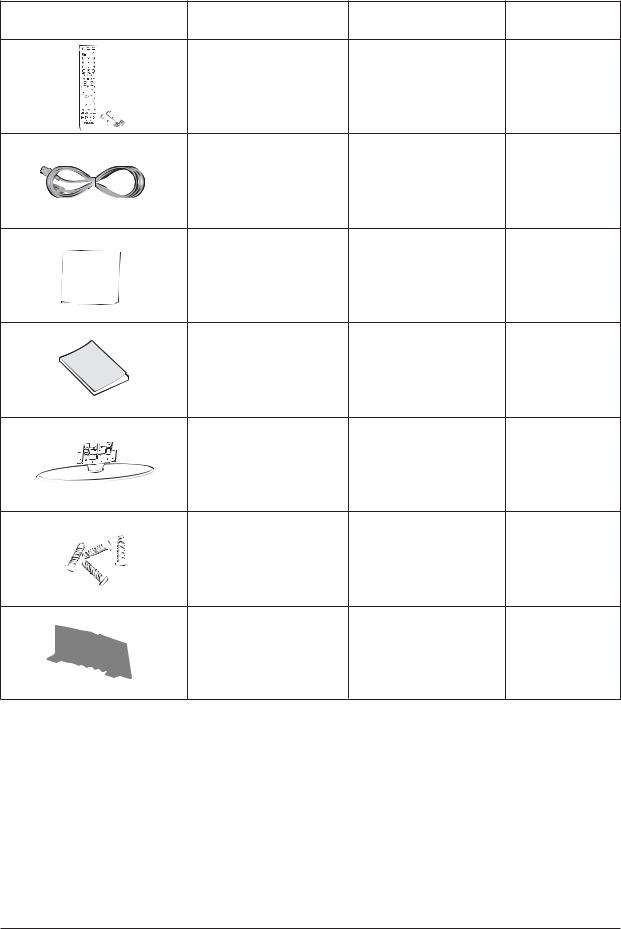
2 Product Specifications
2-7 Option Specification
Item |
Item Name |
Code.No |
Remark |
Remote Control
& BN59-00604A
Batteries (AAA x 2)
Power Cord |
3903-000144 |
Cleaning Cloth |
BN63-001798A |
Owner's
Instructions BN68-00998E
26" : BN90-00913B Stand 32" : BN90-00842A 40" : BN90-00847A
Stand Screw
26" : BN63-02323A Cover-Bottom 32" : BN63-02323A 40" : BN63-02366A
2-7

3 Alignments and Adjustments
3 Alignments and Adjustments
3-1 Service Instruction
1.Usually, a color TV-VCR needs only slight touch-up adjustment upon installation. Check the basic characteristics such as height, horizontal and vertical sync.
2.Use the specified test equipment or its equivalent.
3.Correct impedance matching is essential.
4.Avoid overload. Excessive signal from a sweep generator might overload the front-end of the TV. When inserting signal markers, do not allow the marker generator to distort test result.
5.Connect the TV only to an AC power source with voltage and frequency as specified on the backcover nameplate.
6.Do not attempt to connect or disconnect any wire while the TV is turned on. Make sure that the power cord is disconnected before replacing any parts.
7.To protect aganist shock hazard, use an isolation transform.
3-1

3 Alignments and Adjustments
3-2 How to Access Service Mode
3-2-1 Entering Factory Mode
1.To enter "Service Mode" Press the remote -control keys in this sequence : - If you do not have Factory remote - control
Power OFF |
|
|
|
MUTE |
|
|
|
1 |
|
|
|
8 |
|
|
|
2 |
|
|
|
Power On |
|
|
|
|
|
|
|
|
|
|
|
|
|||||||||
|
|
|
|
|
|
|
|
|
|
|
|
|
|
|
|
|
|
|
|
|
- If you have Factory remote - control |
|
|
|
|
|
|
|
|
|
|
|
|
|
|||||||
PICTURE ON 

 DISPLAY
DISPLAY 

 FACTORY
FACTORY
-The buttons are active in the service mode.
1.Remote - Control Key : Power, Arrow Up, Arrow Down, Arrow Left
Arrow Right, Menu, Enter, Number Key(0~9) 2. Function - Control Key : Power, CH +, CH -, VOL +, VOL -,
Menu, TV/VIDEO(Enter)
3-2

3 Alignments and Adjustments
3-3 Factory Data
1. |
Calibration |
|
2. |
Option Table |
XXXX XXXX |
3.W/B
4.W/B Movie
5.MTK8202
6.FBE2 Option
7.Sound
8.YC Delay
9.Adjust
10.Bus Stop
11. |
Password |
80 80 80 80 |
12. |
Checksum |
0000 |
13.Dynamic Contrast
14.Spread Spectrum
15.Reset
HDCP |
Write |
Success.. |
|
|
T_BDPMNSA-1000 Aug 04 2006 16:41:30 ------------------- |
(Main Micom Ver) |
|||
Month/ Day / Year / Hour/ Min./Sec. |
|
|||
Panel On Time(Hour) |
XXXXX |
|
||
TV |
Air |
2 |
XX |
|
1.Calibration
1)AV Calibration
2)DTV Calibration
3)PC Calibration
4)HDMI Calibration
2.Option Byte
inch Option |
32 |
Carrier Mute |
ON |
Shop Mode |
OFF |
|
|
|
|
|
|
Gamma |
AUO |
Auto FM |
ON |
Debug |
OFF |
Panel option |
AUO_AMVA |
High Dev. |
OFF |
Dynamic Contrast |
OFF |
2HDMI |
OFF |
ACR |
OFF |
V-Chip |
OFF |
|
|
|
|
|
|
Brt,Sensor |
OFF |
Dynamic CE |
ON |
|
|
EnergySave |
ON |
Dynamic Dimming |
ON |
|
|
|
|
|
|
|
|
LBE/FBE |
OFF |
Color System |
Manual |
|
|
|
|
|
|
|
|
FRC(Micronas) |
OFF |
Auto Power |
ON |
|
|
|
|
|
|
|
|
FRC(Samsung) |
OFF |
Magazine LNA |
OFF |
|
|
|
|
|
|
|
|
LNA |
OFF |
V-Chip Area |
US |
|
|
|
|
|
|
|
|
3-3

3 Alignments and Adjustments
1.Calibration
2.Option Table
AV Calibration |
EXE |
DTV Calibration |
EXE |
PC Calibration |
EXE |
HDMI Calibration |
EXE |
|
|
Inch Option |
26" |
32" |
40" |
Gamma |
AUO |
AUO |
AMLCD |
Panel Option |
AUO |
AUO_AMVA AMLCD_INT |
|
2Hdmi |
OFF |
OFF |
OFF |
Brt. Sensor |
OFF |
OFF |
OFF |
EnergySave |
ON |
ON |
ON |
LBE/FBE |
OFF |
OFF |
OFF |
FRC(Micronas) |
OFF |
OFF |
OFF |
FRC(Samsung) |
OFF |
OFF |
OFF |
LNA |
OFF |
OFF |
OFF |
Carrier Mute |
ON |
ON |
ON |
Auto FM |
ON |
ON |
ON |
High Deviation |
OFF |
OFF |
OFF |
ACR |
OFF |
OFF |
OFF |
Dynamic CE |
ON |
ON |
ON |
Dynamic Dimming |
ON |
ON |
ON |
Color System |
Manual |
Manual |
Manual |
Auto Power |
ON |
ON |
ON |
Magazine LNA |
OFF |
OFF |
OFF |
V-Chip Area |
US |
US |
US |
Shop Mode |
OFF |
OFF |
OFF |
Debug |
OFF |
OFF |
OFF |
Dynamic Contrast |
OFF |
OFF |
OFF |
V-Chip |
OFF |
OFF |
OFF |
|
|
|
|
3. White Balance |
|
|
Sub Brightness |
104 |
104 |
104 |
|
||||||
|
|
|
R-Offset |
122 |
122 |
122 |
|
|
|
G-Offset |
128 |
128 |
128 |
|
|
|
B-Offset |
129 |
129 |
129 |
|
|
|
Sub Contrast |
165 |
155 --> 140 |
155 --> 140 |
|
|
|
R-Gain |
137 |
137 |
137 |
|
|
|
G-Gain |
128 |
128 |
128 |
|
|
|
B-Gain |
136 |
136 |
136 |
|
|
|
|
|
|
|
3-4

|
|
|
|
|
3 Alignments and Adjustments |
4. SVP-PX |
|
|
|
|
|
|
|
ComB Filter |
Y-Filter |
80H |
|
|
|||||
|
|
|
Sharpness |
H2Gain |
00H |
|
|
|
|
H4Gain |
0CH |
|
|
|
|
V2Gain |
00H |
|
|
|
|
V4Gain |
0CH |
|
|
|
|
Sr2Gain |
00H |
|
|
|
|
Sr4Gain |
08H |
|
|
|
|
Sl2Gain |
00H |
|
|
|
|
Sl4Gian |
08H |
|
|
|
|
PeaKTh1 |
03H |
|
|
|
|
PeaKTh2 |
33H |
|
|
|
|
PeaKTh3 |
45H |
|
|
|
NR |
Y_NR_OFF |
80H |
|
|
|
|
C_NR_OFF |
80H |
|
|
|
|
Y_NR_ON |
80H |
|
|
|
|
C_NR_ON |
80H |
|
|
|
|
|
|
RGB Calibration R-Offset |
23H |
G-Offset |
23H |
B-Offset |
23H |
R-Gain |
9BH |
G-Gain |
9BH |
B-Gain |
9BH |
|
|
ADC Calibration |
TCD3 Contrast |
6AH |
|
TCD3 Brightness |
26H |
|
TCD3 CR |
80H |
|
TCD3 CB |
80H |
|
TCD3 Delay |
00H |
|
Analog Y Offset |
40H |
|
Analog PB Offset |
80H |
|
Analog PR Offset |
80H |
|
Analog Y Gain |
D6H |
|
Analog PB Gain |
FEH |
|
Analog PR Gain |
FEH |
|
Black Level |
00H |
|
Svp Brightness |
00H |
|
|
|
3-5

3 Alignments and Adjustments |
|
|
|
|
|
|
|||
|
|
|
|
|
|
|
|
|
|
|
|
|
|
|
|
|
|
low high |
delta |
|
|
|
|
Calibration Target |
AV ADC |
17H D5H |
04H |
||
|
|
|
|
|
|
|
COMP ADC |
0FH EBH |
02H |
|
|
|
|
|
|
|
PC ADC |
17H D5H |
04H |
|
|
|
|
|
|
|
ALL RGB |
00H DDH |
08H |
|
|
|
|
|
|
|
|
|
|
|
|
|
|
|
|
|
|
|
|
|
|
|
|
Color Management |
Skin Direction |
Reddish |
|
||
|
|
|
|
|
|
|
Skin Enhane |
40H |
|
5. Option block |
|
|
|
|
|
|
|
|
|
|
|
|
|
|
|
|
|
||
|
|
|
|
EXE |
|
|
|
||
|
|
|
|
|
|
|
|||
6. STV8258/STA323W |
|
|
|
|
|
|
|||
|
|
|
|
|
|
||||
|
|
|
Ch1 Volume |
40H |
|
||||
|
|
|
|
||||||
|
|
|
|
|
|
Ch2 Volume |
40H |
|
|
|
|
|
|
|
|
Stereo Pilot H |
23H |
|
|
|
|
|
|
|
|
Stereo Pilot L |
10H |
|
|
|
|
|
|
|
|
Sap Pilot H |
|
80H |
|
|
|
|
|
|
|
Sap Pilot L |
|
60H |
|
|
|
|
|
|
|
SQTH |
|
70H |
|
|
|
|
|
|
|
CETH |
|
10H |
|
|
|
|
|
|
|
AV Delay |
|
55H |
|
|
|
|
|
|
|
Comp delay |
32H |
|
|
|
|
|
|
|
|
HDMI Delay |
32H |
|
|
|
|
|
|
|
|
PC Delay |
|
32H |
|
|
|
|
|
|
|
L1 Att/Rel Thres |
7F |
|
|
7. Y/C Delay |
|
|
|
|
|
|
|
|
|
|
|
|
|
|
|
|
|||
|
|
|
RF PAL-M |
|
77H |
|
|||
|
|
|
|
|
|||||
|
|
|
|
|
|
RF PAL-N |
|
64H |
|
|
|
|
|
|
|
RF NTSC |
|
63H |
|
|
|
|
|
|
|
AV PAL-M |
|
76H |
|
|
|
|
|
|
|
AV PAL-N |
|
76H |
|
|
|
|
|
|
|
AV NTSC |
|
54H |
|
|
|
|
|
|
|
S-VIDEO PAL-M |
77H |
|
|
|
|
|
|
|
|
S-VIDEO PAL-N |
77H |
|
|
|
|
|
|
|
|
S-VIDEO NTSC |
BBH |
|
|
|
|
|
|
|
|
Component |
|
88H |
|
|
|
|
|
|
|
PC |
|
88H |
|
|
|
|
|
|
|
HDMI |
|
88H |
|
|
|
|
|
|
|
|
|
|
|
3-6

8. Adjust
9.I2C Check
10.W/B MOVIE
3 Alignments and Adjustments
Video Mute Time |
|
10 |
Vol Curve |
|
Large |
Melody Volume |
|
4 |
Ana_Dimm_Max |
|
FEH |
LNA PLUS |
RFDB-1 Level |
2 |
|
RFDB-2 Level |
5 |
|
RFDB-3 Level |
9 |
|
RFDB-4 Level |
24 |
Hotel Option |
Hotel Mode |
OFF |
|
Power On Channel |
1 |
|
Power On Volume |
10 |
|
Max Volume |
100 |
|
Local Key Lock |
OFF |
|
Power On Source |
RF |
|
|
|
EXE
WB Movie |
OFF |
|
Color Mode |
Movie |
|
W1 |
R Gain |
157 |
W1 |
B Gain |
76 |
W1 |
R Offset |
119 |
W1 |
B Offset |
138 |
W2 |
R Gain |
142 |
W2 |
B Gain |
48 |
W2 |
R Offset |
129 |
W2 |
B Offset |
143 |
Movie Contrast |
80 |
|
Movie Brightness |
65 |
|
Movie Color |
35 |
|
Movie Sharpness |
35 |
|
Movie Color Tone |
Warm2 |
|
|
|
|
3-7

3 Alignments and Adjustments
11. Checksum |
18EA |
|
12. |
Reset |
|
|
|
EXE |
|
|
|
|
||||
|
|
|
|
|
|
|
13. |
Spread Spectrum |
|
|
|
|
|
|
|
|
||||
|
|
Spectrum |
ON |
|||
|
||||||
|
|
|
|
|
Delta |
3 |
|
|
|
|
|
Positive |
8 |
|
|
|
|
|
Negative |
2 |
|
|
|
|
|
|
|
3-8
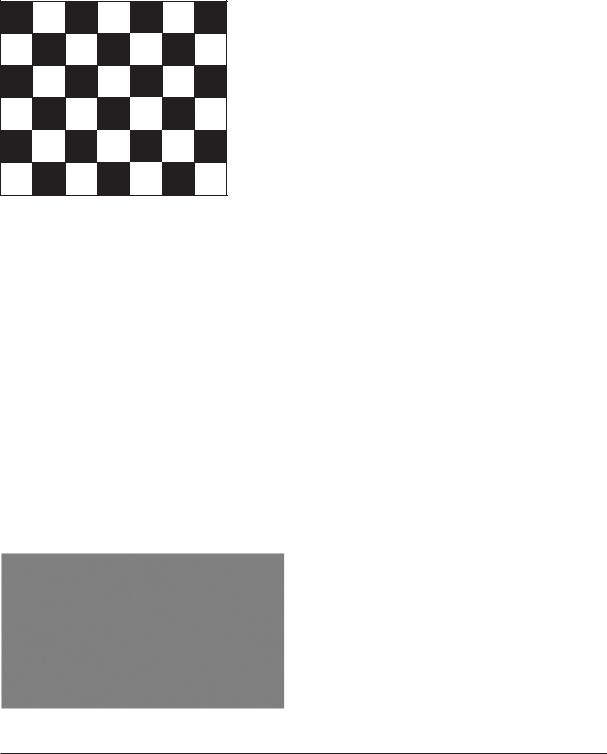
3 Alignments and Adjustments
3-4 Service Adjustment
3-4-1 White Balance - Calibration
If picture color is wrong, do calibration first.
Equipment : CA210, Patten : chess pattern
Execute calibration in Factory Mode
Source AV : PAL composite, Component : 1280*720/60Hz
PC : 1024*768/60Hz
( chess patten )
3-4-2 White Balance - Adjustment
If picture color is wrong, check White Balance condition.
Equipment : CA210, Patten : Toshiba
Adjust W/B in Factory Mode
Sub brightness and R/G/B Offset controls low light region
Sub contrast and R/G/B Gain controls high light region
Source AV : PAL composite, Component : 1280*720/60Hz
HDMI[DVI] : 1280*720/60Hz
[ Test Pattern : MSPG-945 Series Pattern #92 ]
*Color temperature
1500K +/-500, -6 ~-20 MPCD
*Color coordinate |
|
H/L : 267/263 +/- 2 |
35.0 Ft +/- 2.0Ft |
L/L : 270/260 +/- 3 |
1.5 Ft +/- 0.2Ft |
W/B Patten |
|
3-9

3 Alignments and Adjustments
3-4-3 Conditions for Measurement
1.On the basis of toshiba ABL pattern : High Light level (57 IRE) - INPUT SIGNAL GENERATOR : MSPG-925LTH
* Mode |
NO |
1 |
: |
744X484@60 Hz |
|
NO |
2 |
: |
744X484@60 Hz |
|
NO |
6 |
: |
1280X720@60 Hz |
|
NO 21 |
: |
1024X768@60 Hz |
|
* Pattern |
NO |
36 |
: |
16 Color Pattern |
|
NO |
16 |
: |
Toshiba ABL Pattern |
|
NO |
92 |
: |
W/B Pattern |
2.Optical measuring device : CA210 (FL)
Please use the MSPG-925 LTH generator for model LE26M51B/LE32M51B/LE40M51B/LE46M51B.
3-4-4 Method of Adjustment
1. Adjust the white balance of AV, Component and DVI Modes.
(AV  Component)
Component)
a) Set the input to the mode in which the adjustment will be made (RF  DTV
DTV  PC
PC  DVI).
DVI).
*Input signal - VIDEO Mode : Model #2 (744*484 Mode), Pattern #16
-DTV,DVI Mode : Model #6 (1280*720 Mode), Pattern #16
-HDMI Mode: Model #6(1280*720 Mode), Pattern #16
b)Enter factory color control, confirm the data.
c)Adjust the low light. (Refer to table 1, 2 in adjustment position by mode)
-Adjust sub - Brightness to set the 'Y' value.
-Adjust red offset ('x') and blue offset ('y') to the color coordinates.
Picture 4-2 W/B Patten
*Do not adjust green offset data.
d)Adjust the high light. (Refer to table 1, 2 in adjustment position by mode) - Adjust red gain ('x') and blue gain ('y') to the color coordinates.
*Do not adjust the green gain and sub-contrast (Y) data.
3-10

3 Alignments and Adjustments
Picture 4-3 W/B Patten
3-11
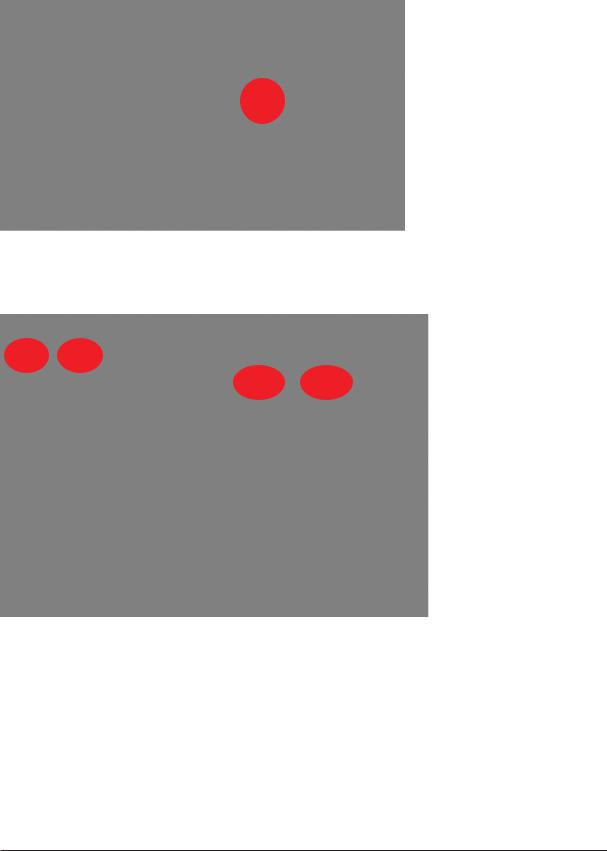
3 Alignments and Adjustments
3-5 Software Upgrade
3-5-1 How to Update Flash ROM (with RS-232C Cable)
1.Installthe Flash Downloader
ConnectSet(Service Jack)and Jig Cable to execute Program Update.
2.Turn on the Set (or on Stand by mode) - Run "MTKtool"
-Click Reset 
-Choose MT8202 (1)
-Select Com Port (2) (Auto Detect)
-Select Bin file, by browse (3)
-Click Upgrade button (4)
3. Turn off (= AC Power off) the Set (waiting a few seconds) and turn on again.
3-12
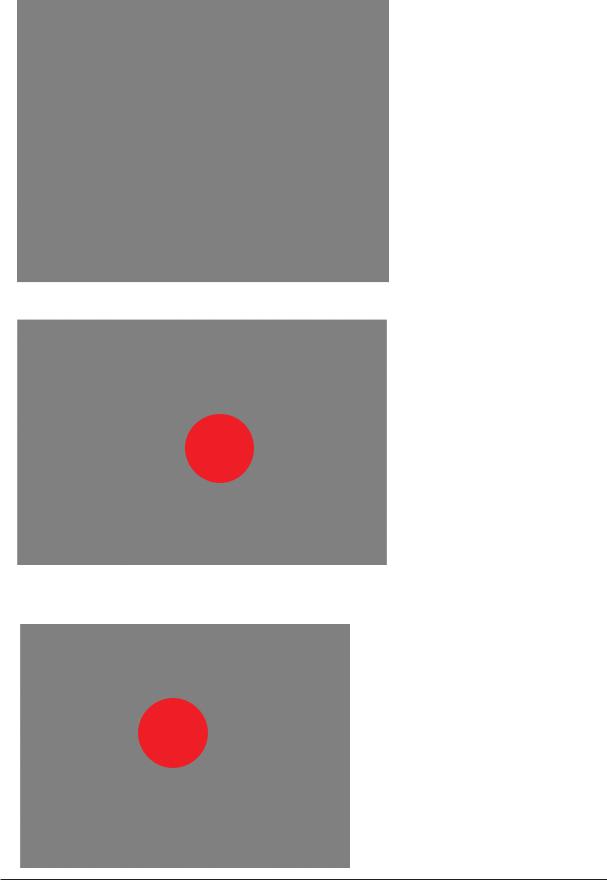
3 Alignments and Adjustments
3-5-2 How to Update Flash ROM (with UART JIG)
¡Ø In the usual cases, Update S/W by using RS-232C Cable.
If some problems occur under this condition, update S/W by using UART JIG.
You can use UART JIG with USB Connection.
Install  in your PC before using the JIG
in your PC before using the JIG
Connect 4P Lead connector to Main Board(CN501)
3-13

3 Alignments and Adjustments
* Pin Assignment
Turn on the Set (or on Stand by mode) - Run "MTKtool"
When you run "MTKtool", this Program can detect USB port automatically Choose USB interface and Update S/W as RS-232C case.
3-14

4 Troubleshooting
4 Troubleshooting
4-1 First Checklist for Troubleshooting
1.Check the various cable connections first.
-Check to see if there is a burnt or damaged cable.
-Check to see if there is a disconnected cable connection or a connection is too loose.
-Check to see if the cables are connected according to the connection diagram.
2.Check the power input to the Main Board.
3.Check the voltage in and out between the SMPS
 Main Board, between the SMPS
Main Board, between the SMPS 
 INVERTER Board, and between the Main LVDS Boards.
INVERTER Board, and between the Main LVDS Boards.
4-1
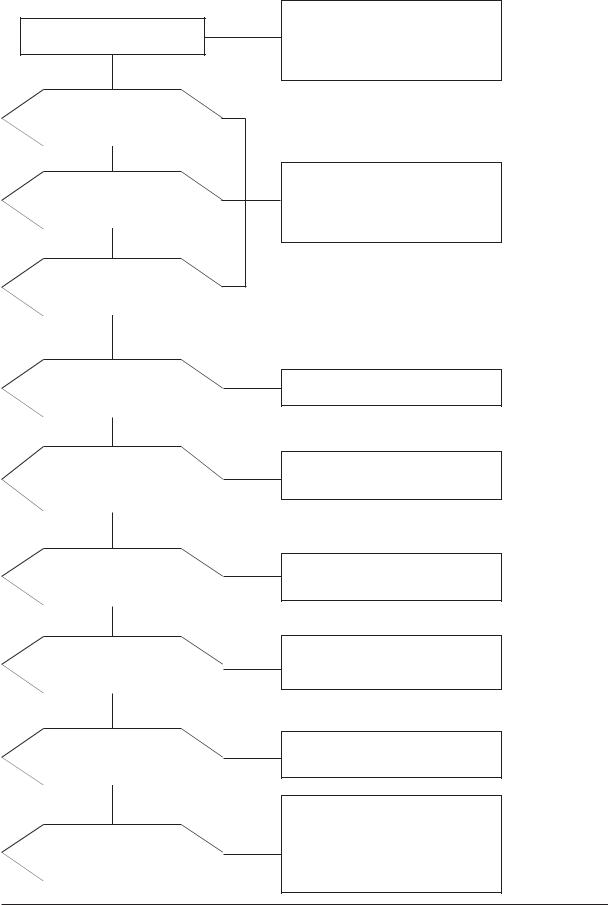
4 Troubleshooting
4-2 Checkpoints by Error Mode
4-2-1 No Power
LAMP off, power indicator LED red color?
Yes
Does proper Satand-By DC A5V appear at C127
Does proper Main DC B12V, B5V, B12VS appear at C104, BD105, C119?
Does proper Inverter DC 24V appear at CNM801 in SMPS
Yes
Does proper DC A3.3V,A1.8Vappear at C126, C156?
Yes
Does proper DC B9V,B3.3V_8202/B3.3VD, B2.5V_8202 appear at C103,C132, C145?
Yes
Does proper DC 5V, 3.3V, 1.8V appear at C811, C853, C833?
Yes
Does proper DC B3.3FB, B1.2FB, B1.8VD appear at C179_FBE, C182_FBE, C159?
Yes
Does proper DC B3.3VD appear at D8014?
Yes
A power is supplied to set?
No
No
No
No
No
No
No
Check a connection a power cable. P/N : BN39-00802A BN39-00802B(40")
Change the Main Power Ass'y
23" : BN44-00158A
26" : BN44-00156A
32" : BN44-00156A
40" : BN44-00167A/00165A
Check IC104, IC107 Change the
Main Ass'y
Check a IC809, IC802.
Change a main PCB ass'y.
Check IC101, IC105, IC106 Change the
Main Ass'y
Check IC110_FBE, IC111_FBE, IC109
Change the Main Ass'y
Check IC8001
Change the Main Ass'y
Check a other function(No picture part) Replace a LCD Panel
23" : BN07-00365A
26" : BN07-00254A
32" : BN07-00385A
40" : BN07-00387A
4-2
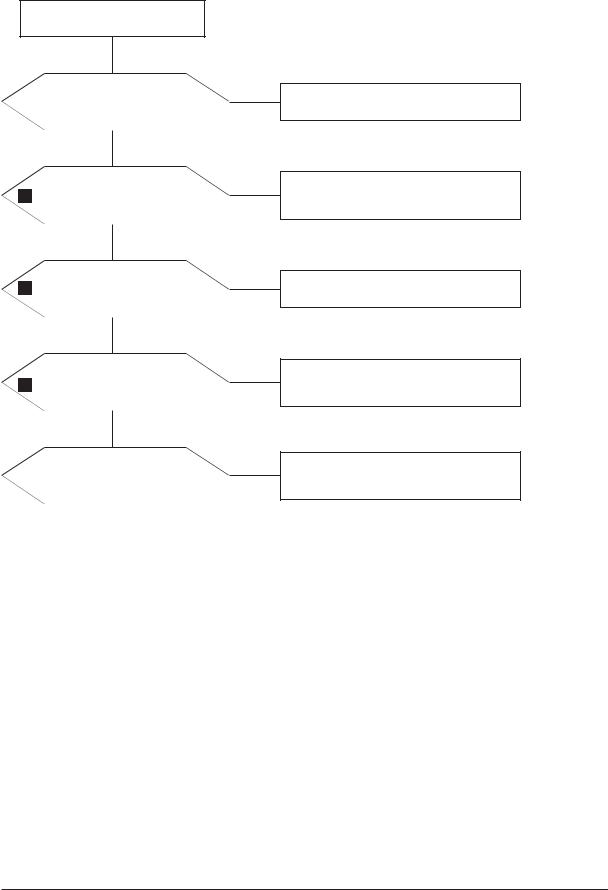
4 Troubleshooting
4-2-2 No Video (Analog PC Signal)
Power Indicator is off.
Lamp on, no video.
Yes
Check the PC source and check the connection of DSUB?
Yes
Does the signal appear at 1 #R25, T25, T24, U24, V25,
V26(R,G,SOG,B,V,H) of
IC602?
Yes
Does the digital data appear at 2 output of R916_FBE ~
R921FBE?
Yes
Does the digital data appearat 3 output of R1001_FBE ~
R1017_FBE?
Yes
Check the LVDS cable?
Replace the LCD panel?
No
No
No
No
No
Input an analog PC signal. check the connected cable.
Check JA306, PC cable. Change the PC cable.
Change the main PCB Ass'y.
Check IC602. Change the main PCB Ass'y.
Check IC 901_FBE Change the main PCB Ass'y.
Please, call to Samsung Co. LTD
4-3

4 Troubleshooting
WAVEFORMS
1 2 PC Input (V-Sync, H-Sync)
3 LVDS Out (CLK +/-)
4-4
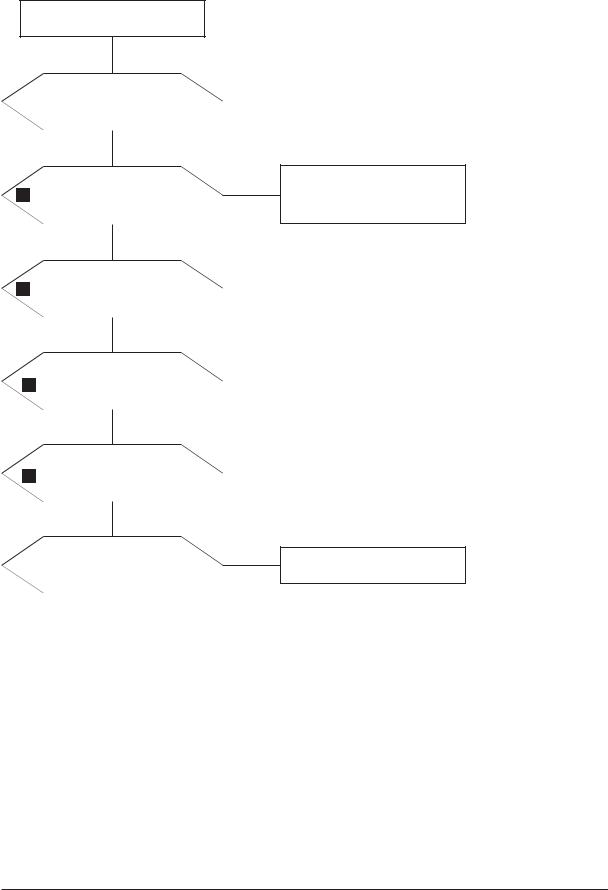
4 Troubleshooting
4-2-3 No Video (HDMI - Digital Signal)
Power Indicator is off.
Lamp on, no video.
Yes
Check the HDMI source and check the connection of HDMI cable?
Yes
Does the signal appear at 4 R461,R464,R457,R458,R454,
R456,R467-R474?
Yes
5Does the digital data appear at output of R738 ~ R745?
Yes
Does the digital data appear 2 at output of R916_FBE ~
R921FBE?
Yes
Does the digital data appearat 3 output of R1001_FBE ~
R1017_FBE?
Yes
Check the LVDS cable?
Replace the LCD panel?
No |
Input a HDMI signal. |
|
|
|
check the connected cable. |
|
|
Check JA801, JA802, No HDMI cable.
Change the HDMI cable. Change the main PCB Ass'y
No |
Check IC405 |
|
|
|
Change the main PCB Ass'y. |
|
|
No |
Check IC601. |
|
|
|
Change the main PCB Ass'y. |
|
|
No |
Check IC 901_FBE |
|
|
|
Change the main PCB Ass'y. |
|
|
No
Please, call to Samsung Co. LTD
4-5
